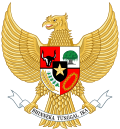Fourth Development Cabinet Kabinet Pembangunan IV | |
|---|---|
| 31st Cabinet of Indonesia | |
| 1983–1988 | |
 | |
| Date formed | 19 March 1983 |
| Date dissolved | 21 March 1988 |
| People and organisations | |
| Head of government | Suharto |
| No. of ministers | 32 ministers |
| Member parties | |
| Status in legislature | Coalition |
| History | |
| Predecessor | Development III Cabinet |
| Successor | Development V Cabinet |
| ||
|---|---|---|
Pre-presidency Domestic policy Foreign policy Post-presidency Family
| ||
| Gallery: Picture, Sound, Video | ||
The Fourth Development Cabinet (Indonesian : Kabinet Pembangunan IV) was the Indonesian cabinet which served under President Suharto and Vice President Umar Wirahadikusumah from March 1983 until March 1988. The cabinet was formed after Suharto was elected to a 4th term as president by the People's Consultative Assembly (MPR).



